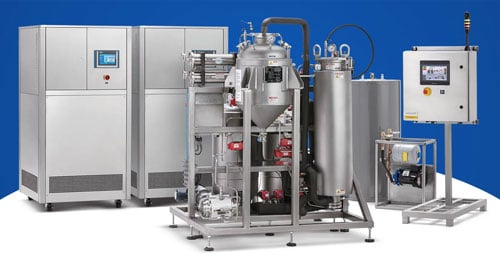Discover the critical differences between simple and fractional distillation, and learn how each process is used in various industries.
Understanding Distillation: An Overview
Distillation is widely used for separating liquid mixtures based on their different boiling points. It involves heating the mixture to vaporize the more volatile component and then condensing the vapor back into liquid form. This process allows for separating different components in the mixture, which can have various applications in different industries.
One of the main goals of distillation is to obtain a purified product, whether it's alcohol, essential oils, or cannabinoids and terpenes. The process relies on the fact that different components in a mixture have different boiling points. By carefully controlling the temperature and pressure, it is possible to selectively vaporize and condense specific components, effectively separating them from the rest of the mixture.
Distillation can be broadly classified into two main types: simple and fractional. While both methods aim to achieve the same goal, they differ in their efficiency and effectiveness in separating different components.
Simple Distillation: Basic Principles and Applications
Simple distillation is the most basic form of distillation and is often used for separating components with a significant difference in boiling points. It involves heating the mixture and collecting the vapor that is produced. The vapor is then cooled and condensed to obtain the purified liquid.
Simple distillation works best when the boiling points of the components in the mixture are significantly different, ideally by at least 25-30 degrees Celsius. This ensures that the vapor produced predominantly comprises one component, making the separation more effective.
This method is commonly used in the production of distilled water, as the boiling point of water is significantly lower than that of other impurities. It is also used in the purification of alcohol and the separation of volatile solvents in the chemical industry.
Fractional Distillation: Enhanced Separation and Efficiency
Fractional distillation is a more advanced technique used when the boiling points of the components in the mixture are closer together. It involves using a fractionating column, which provides a larger surface area for vaporization and condensation.
The fractionating column consists of several trays of packing materials that help to create multiple vapor-liquid equilibrium stages. As the vapor rises through the column, it comes into contact with the liquid, allowing for further separation of the components based on their boiling points.
Fractional distillation is highly efficient and allows the separation of components with similar boiling points. It is commonly used in the petroleum industry to separate crude oil into various fractions, such as gasoline, diesel, and kerosene. It is also used in the production of alcoholic beverages and the purification of specialty chemicals.
Comparing Simple and Fractional Distillation Techniques
One of the main differences between simple and fractional distillation is their effectiveness in separating components with similar boiling points. Simple distillation is suitable for mixtures with a significant difference in boiling points, while fractional distillation is more effective for mixtures with more minor differences.
Another key difference is the presence of a fractionating column in fractional distillation. This column allows for creating multiple vapor-liquid equilibrium stages, enhancing the separation process.
In terms of efficiency, fractional distillation is generally more efficient than simple distillation as it allows for better separation of components. However, simple distillation is more straightforward and requires less equipment, making it suitable for situations where high purity is not necessary.
The choice between simple and fractional distillation depends on the specific mixture being distilled and the desired level of separation and purity.
Applications of Simple and Fractional Distillation in Industry
Simple and fractional distillation has numerous applications in various industries. Some common examples include:
- Simple distillation is used in the production of distilled water, purification of alcohol, and separation of volatile solvents in the chemical industry.
- Fractional distillation is widely used in the petroleum industry to separate crude oil into different fractions, as well as in the production of alcoholic beverages and the purification of specialty chemicals.
These techniques play a vital role in ensuring the production of high-quality products and the efficient separation of components in industrial processes.


